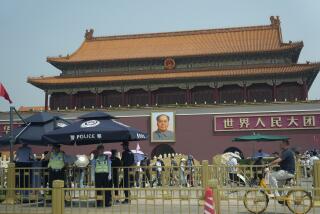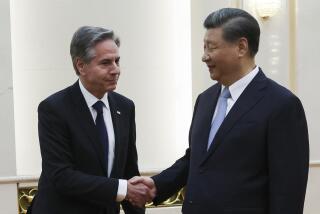China Grows Into Unruly Giant at 50
- Share via
HUANGSHAN, China — For thousands of years, this mountain getaway has been a magnet for Chinese artists and poets seeking inspiration from its misty crags, gnarled pines and stunning views.
But when too many visitors in recent times turned out to be Chinese officials on taxpayer junkets, the Beijing regime last October banned all such trips here, calling them a waste of public money.
That didn’t stop the Huaxi Hotel, a state-owned enterprise that depends heavily on conferences for revenue, from hosting at least two or three government gatherings in the past 12 months, in direct violation of the ban.
Nor did it keep health officials in Liaoning province, 900 miles to the north, from scheduling a three-day meeting here in May to discuss boosting the business of a state-run drug firm. Even more audacious, the officials went ahead with sightseeing plans after disciplinary inspectors from Beijing, on a spot check, caught the cadres at the Huaxi and ordered them to go home.
It was a stark example of a growing reality in this land of 1.3 billion people. Half a century after Mao Tse-tung declared the founding of the People’s Republic, local authorities across China are increasingly ignoring their leaders in Beijing, flouting policy and often frustrating some of the central government’s best-laid plans.
Gone are the days of a monolithic Communist state ruled by fiat from above. The China that celebrates its 50th birthday Friday has in many respects become an unruly behemoth, difficult to govern from the center as market reforms and the clamor for a stake in the new economy take root, from Huangshan in the south to Hohhot in the north.
And as the Middle Kingdom moves into the next millennium, experts say Beijing will have to find new ways of governing the world’s most populous nation, shedding the old trappings of ironfisted Communist rule and reconciling the centrifugal forces that have turned China into a dynamic and creative but often corrupt and chaotic nation.
“The idea that you can control a country as large and far-flung as China with a set of central policies is just a nonstarter today,” said Richard Baum, a political scientist at UCLA.
Although some leaders in Beijing still try to run the show the old-fashioned way, using China’s creaky Leninist machinery, new experiments in governance have sprung up across the country, ranging from village elections to a halting attempt at establishing the rule of law.
What will ultimately emerge is still a work in progress. No one can say for certain what China will look like in another 50 years.
But the domestic political picture has undergone profound and seemingly irrevocable change during the past two decades of China’s long march from international isolation toward economic liberalization and engagement with the outside world.
Post-Mao Years
After Mao’s death in 1976, the radical leftism of Communist China’s first 30 years, backed by Stalinist purges and ideological campaigns such as the disastrous Great Leap Forward, finally gave way to the market-oriented pragmatism of Deng Xiaoping. To spur development, the Beijing regime ceded some of the control it had tightly held over its planned economy and encouraged local areas to take responsibility for their own economic performance.
“It’s not that the localities are spinning out of control,” Baum said. “It’s more that they’re having to find success or failure on their own.”
The result of the reforms has been a remarkable increase in living standards for tens of millions of Chinese--perhaps the biggest, most successful project the world has ever seen in lifting huge numbers of people out of abject poverty.
But success has come with a price for the government and its sway over society.
The ideological glue that once bonded leaders and citizens has largely disintegrated, leaving people in search of something besides communism to believe in, such as the mystical Falun Gong sect outlawed this summer.
A yawning income gap between urban and rural areas, between coast and interior, has spawned a disaffected underclass angry with the government. Party control over people’s lives has been further eroded by the growth of the private sector and foreign ventures, freeing many Chinese from the old Leninist system that dominated them.
And the local apparatchiks who once zealously carried out the commands of the Communist leadership have instead turned to more parochial interests, competing with one another for their share of the pie and often resorting to corruption and outright disobedience of edicts from the top.
China “is more out of control than it has been since the [1966-76] Cultural Revolution,” said David Shambaugh, a China scholar at George Washington University. “The number of rural protests, the number of urban strikes, Falun Gong, the alienation among youth, the hedonism of younger people, the total irrelevance of the Communist Party to most people in society--clearly this is a country that is unstable.”
This is not to say that China is anywhere near the brink of anarchy, Shambaugh and others emphasize.
But Beijing has lost many of the levers once available to enforce its will. An effort to streamline China’s bloated bureaucracy has vastly shortened the government’s reach: In 1982, there were 98 ministries and commissions; now there are 27. The number of ministers and vice ministers has been slashed by 90%.
“They don’t have the vertical hierarchy anymore to enforce [policy] down the line,” Shambaugh said. “It just gets watered down. By the time it reaches the county or sub-county level, those guys just shrug their shoulders.”
Examples abound of local defiance of central decrees. The incidents stem most often from economic concerns, as was the case with the Liaoning officials and the Huaxi Hotel in Huangshan. The hotel wanted business, which the officials were willing to give in order to talk about business themselves--how to boost revenue for a state-owned pharmaceutical company back home.
But not all the noncompliance with national directives has economic motives.
Last year, for example, Buyun township in Sichuan province became the first in China to directly elect its leader, although it didn’t have Beijing’s permission to hold such a vote, which was technically illegal. The central government issued a mild rebuke but hasn’t voided the result.
To some degree, Beijing is willing to turn a blind eye toward lower-level shenanigans as long as the provinces keep remitting an adequate amount in taxes to the center.
Still, the Communist leadership has made some moves to shore up power at the center and rein in rebellious subordinates.
Fear of disintegration at the edges is a recurring theme throughout Chinese history, dating back to ancient times. The last dynasty to be overthrown, the Qing, partly fell victim to strangling administrative inefficiency and widespread corruption that weakened enforcement of imperial policy.
The Communists inherited that fear, instituting a strict command system after coming to power in 1949. Ideological campaigns enforced the party line. Throughout most of the ‘50s and early ‘60s, “there was great uniformity of ideological and political power in China,” Baum said.
The subsequent loss of control during Mao’s Cultural Revolution, a lawless decade that still scars many people’s memories, only served to reinforce Beijing’s desire for maintaining strong, centralized authority.
A Rigid Structure
Unfortunately, the rigid structure of Communist government often perpetuated the tension that existed between center and periphery in feudal times. The heavy-handed, top-down rule from Beijing encourages “feigned compliance” from below--officials who smile and nod and produce false data to prove their obedience for fear of punishment--even now, amid greater decentralization.
“Because our system of evaluating cadres is based on economic quotas, in order to get a good evaluation, everyone just gives their superiors whatever statistics they want to see,” said He Qinglian, the Shenzhen-based author of “The Pitfalls of Modernization,” a harsh critique of China’s economic management in the reform era. “From village to township to county to district to province, all the way up to the central government, the information gets inflated at each level.”
To prevent such problems, President Jiang Zemin and Premier Zhu Rongji have tried to stack provincial governments with their own proteges.
In go-go Guangdong, perhaps the most recalcitrant of provinces from Beijing’s perspective, Jiang and Zhu appointed allies to serve as vice governor and party secretary so that they could monitor Guangdong more closely.
But analysts say deeper-rooted changes will be necessary for the center to continue to hold in the People’s Republic.
“I don’t think they’re going to be able to impose greater control in the future--possibly even less,” Baum said. “It’s really going to force some major rethinking about governing China, maybe along federalist lines.
“They have to devolve power in a meaningful, constitutional way to regions, to break China down into manageable units,” he said.
That is easier said than done in a nation where any hint of regional assertions of power, at least politically, can cause hysterics in Beijing over the potential loss of “sovereignty” and “territorial integrity,” two of the regime’s biggest watchwords. Worries about separatism on the edges of the empire, in Tibet and Xinjiang province in the west, haunt China’s leaders.
For now, the country remains in a state of what Shambaugh characterizes as “stable unrest.”
“But,” he said, asking the question confronting China as it enters the new millennium, “what is the threshold between being stable and spinning out of control?”
(BEGIN TEXT OF INFOBOX / INFOGRAPHIC)
Communism in China
Key moments in the evolution of communism in China:
1921: Chinese
Communist Party is founded, nine years after the formation of the Republic of China and collapse of the Qing dynasty.
1927: Nationalist Party led by Chiang Kai-shek attacks the Communists in the beginning of the country’s protracted civil war.
1934: Communists begin their famed Long March to escape Chiang’s troops.
1949: After World War II, the Communists rout the Nationalists, and Mao Tse-tung becomes the chairman of the new People’s Republic of China. Chiang and 2 million followers flee to Taiwan.
1950: Chinese troops join the Korean War against U.N. forces and separately take control of Tibet.
1953-57: Under the first Five-Year Plan, peasants flock into urban areas to work in government factories.
1956: The central government launches the “Hundred Flowers” campaign to encourage greater freedom of expression.
1958: The government launches the Great Leap Forward to reorganize Chinese society for localized industrialization and massive collectivization of the peasants. The plan turns into a catastrophe when workers cannot produce enough food.
1959: Beijing crushes uprising in Tibet.
1961: 30 million city residents are sent to the countryside because of growing urban famine. By 1962, 20 million Chinese had died.
1964: China becomes a nuclear power.
1966-1976: Mao begins the Cultural Revolution to recommit China to the Communist cause, leading to years of chaos. Red Guards roam the country.
1972: President Nixon visits China.
1976: Premier Chou En-lai and Mao die. The influential hard-line “Gang of Four,” including Mao’s wife, is purged from politics.
1978: Deng Xiaoping institutes rural reforms breaking up communes and allowing farmers to cultivate their own plots of land.
1979: China and the United States normalize relations.
1980s: Deng eases government controls over the urban economy, but growing inflation and corruption lead to social unrest.
1989: Beijing sends in tanks, killing hundreds, perhaps thousands, of pro-democracy protesters in the June 4 Tiananmen Square massacre, crushing the growing movement.
1997: Deng dies, and President Jiang Zemin vows to continue reforms. Britain returns Hong Kong to Chinese control.
Compiled by JOHN JACKSON / Los Angeles Times; Sources: Encyclopaedia Britannica, World Book, Facts on File, Times files
More to Read
Sign up for Essential California
The most important California stories and recommendations in your inbox every morning.
You may occasionally receive promotional content from the Los Angeles Times.











